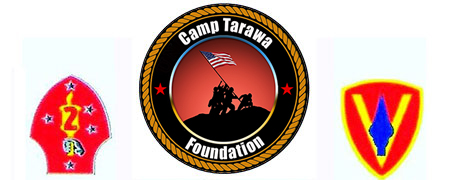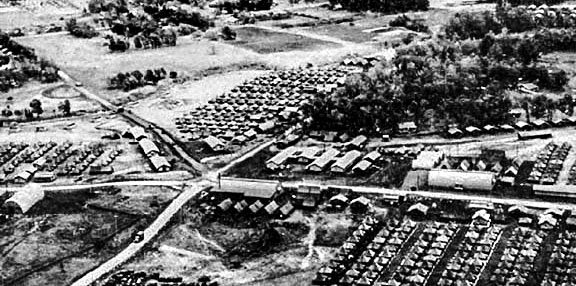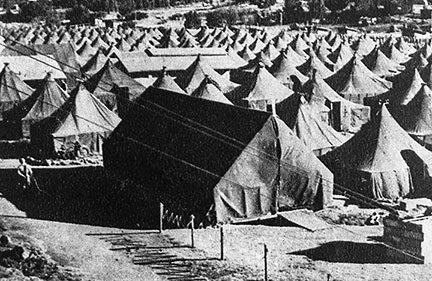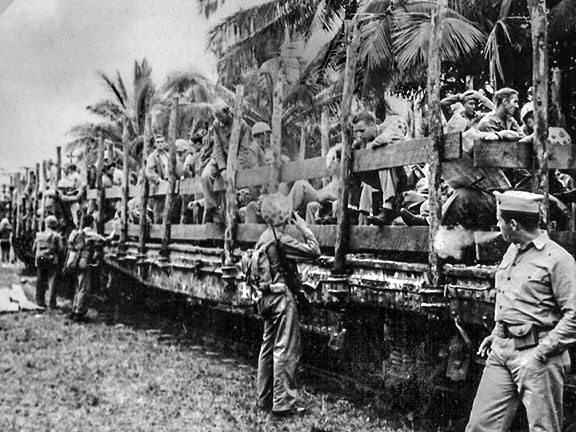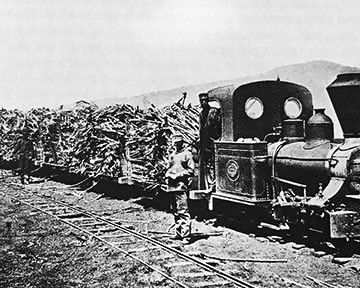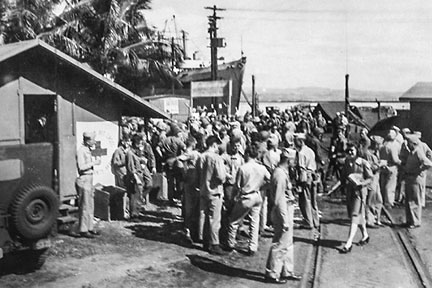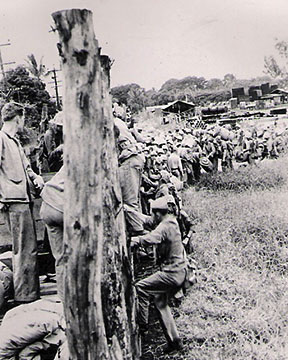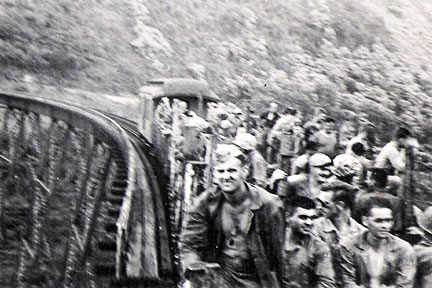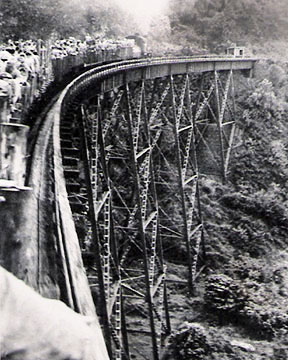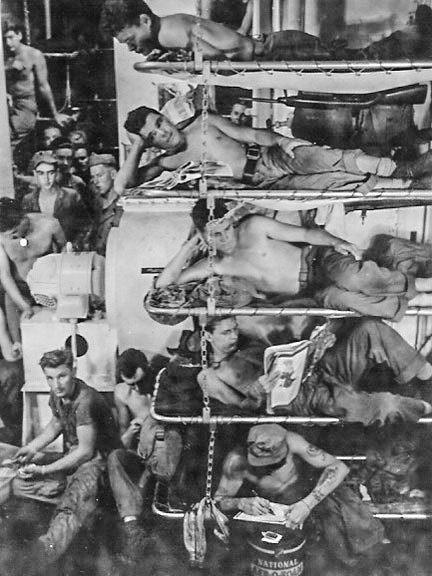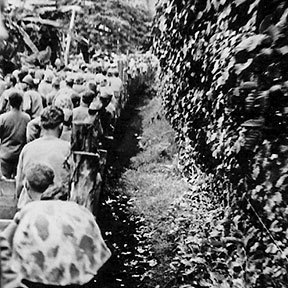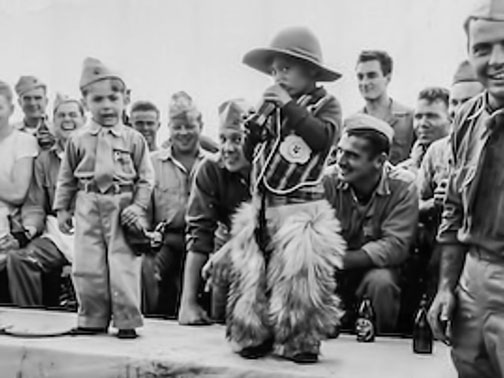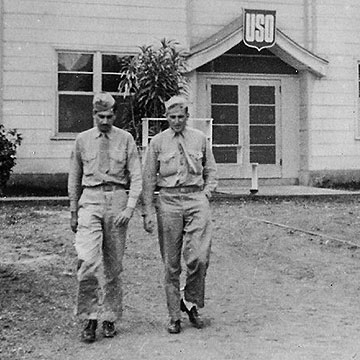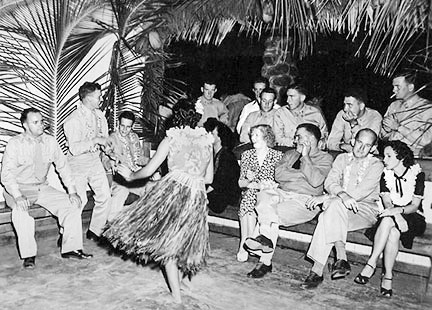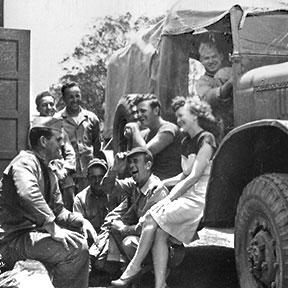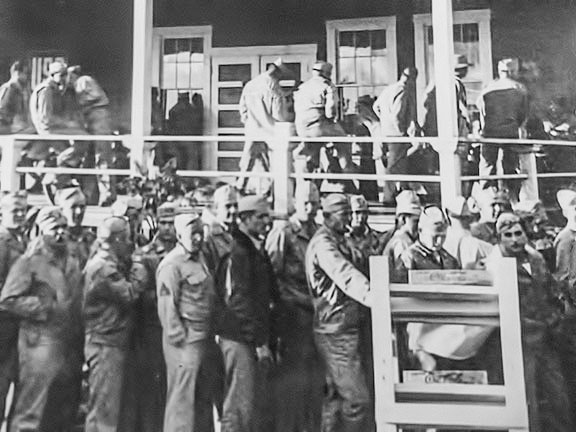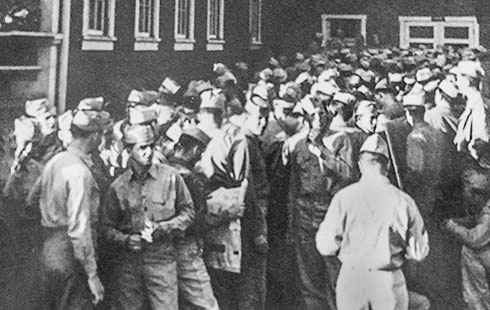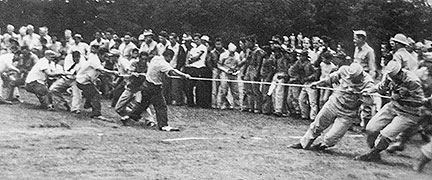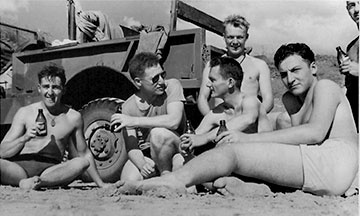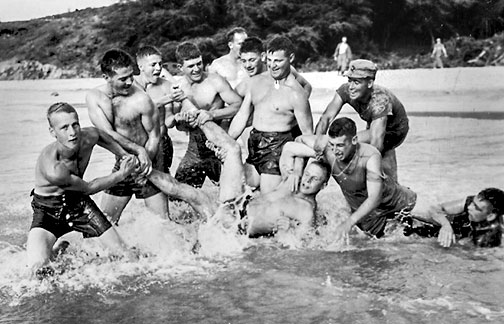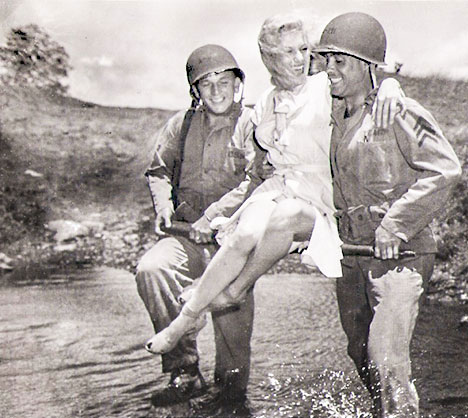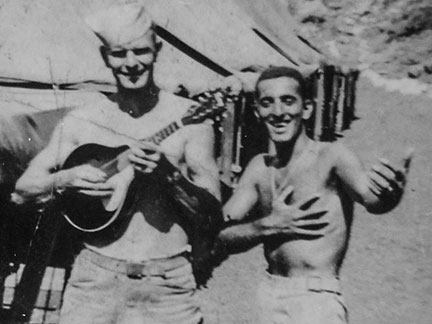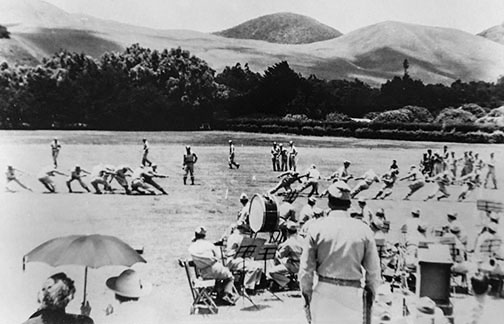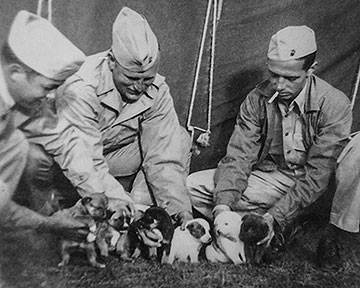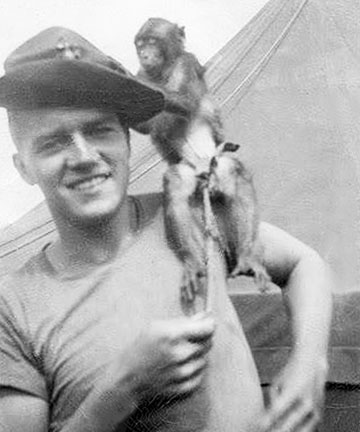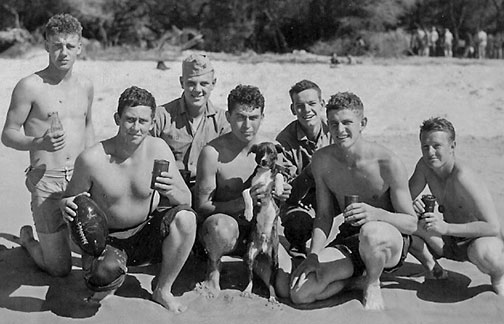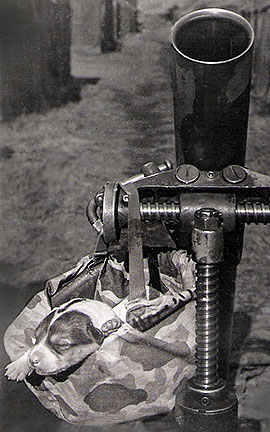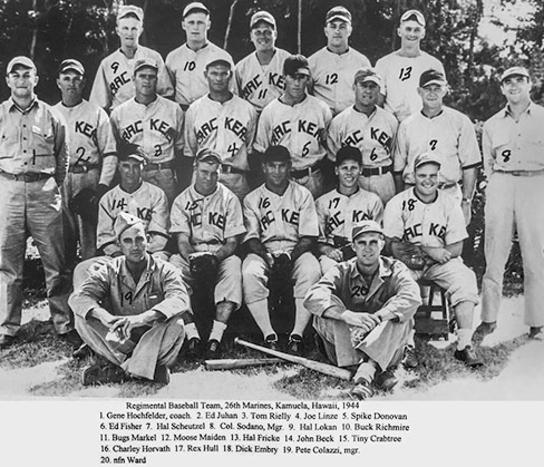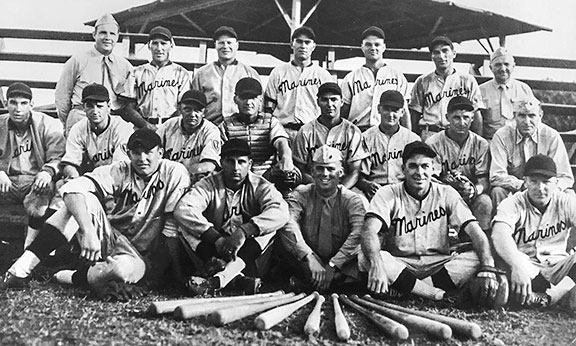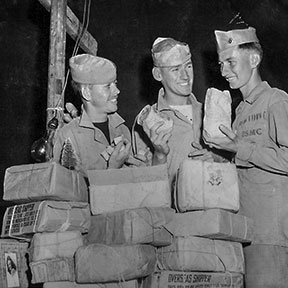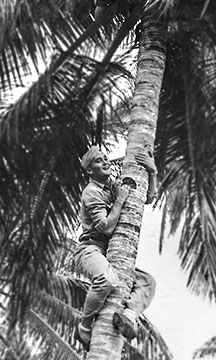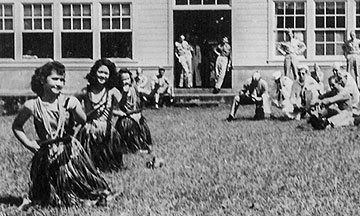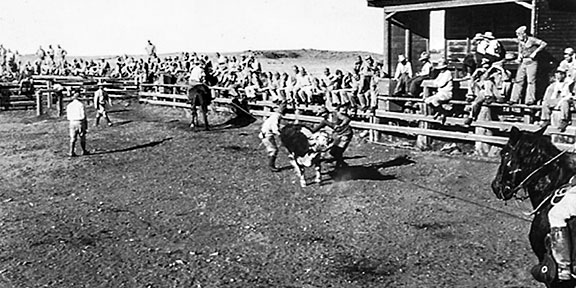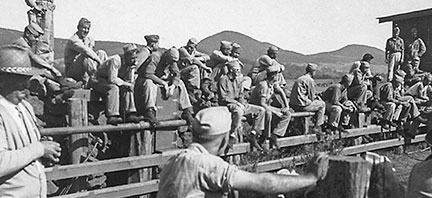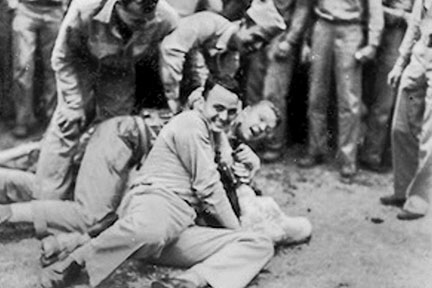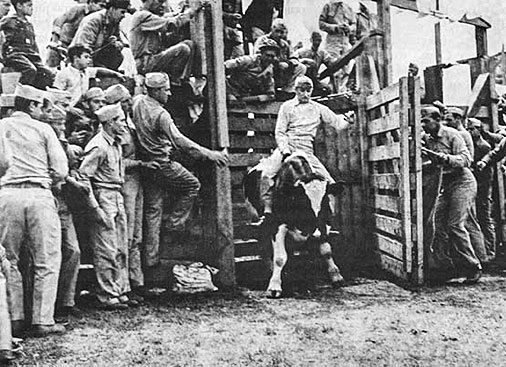2nd and 5th Marine Divisions Camp Tarawa History
Letters
9Feb09
To The Editor,
Camp Tarawa Newsletter
Kamuela, Hawaii
I received the most recent edition of your newsletter from Tom Young in Medford Oregon. He is the son of then 1st Lieutenant Fergus Young, when we left Guadalcanal and sailed for New Zealand to camp Pauaatani about thirty miles from Wellington we were billeted in two man huts. Fergie and I were bunk mates until, out of all of the Lieutenants in the entire 10th Regiment, Fergie was selected to be the Aide for the newly selected BGen T. E. Burke. We were proud of having a flag officer as the only Regimental Commander in the 2nd Marine Division. Tom’s father served in both the 2nd and 5th Marine Divisions. At Guadalcanal Fergie had been decorated with the Purple Heart and was a good bunk mate because he neither smoked nor drank.
After the battle of Tarawa we boarded the Navy Transport USS Grimsby two or three days after Thanksgiving and sailed for, according to “scuttlebutt” a rest camp. We hoped we would be going back to New Zealand. When we put into the island of Oahu we knew it was bad dope.
At Oahu we offloaded some of our wounded and a few Jap prisoners, we were told that none of us could leave the ship. Sailors from a destroyer tied up on the opposite side of the pier heard that we had fought the battle of Tarawa and began throwing up to all of us standing at the rail, cigarettes and chewing gum. They returned to their ship, went below decks and came back out on the pier and threw some chocolate bars. About mid- afternoon of the same day we were told to fall out on the pier and march up and down for exercise and came back aboard.
When we cast off at Oahu we knew we were sailing for the island of Hawaii. We offloaded at Hilo and boarded trucks to get to our “Rest Camp”. We were permitted to drive through a part of the huge Parker Ranch. A part of the time we drove on hardened lava beds. We offloaded on a large barren treeless land. Soon trucks appeared and dropped off tents at intervals as the truck kept moving slowly. A few hours later another truck came along and dropped on the tent folded on the ground a hind quarter of beef wrapped in cheese cloth. The beef began to collect the dust of the passing trucks. More trucks came by dropping off canvas folding cots and blankets as we were pitching tents.
As a 2nd Lt. I had the responsibility of seeing that every man in our battalion had two blankets by bed time. We soon learned that it was cold and windy at night at our new camp site. I lined my cot with pieces of paper and cardboard for additional warmth.
Seabees showed up and built a shower house, then a field “head” for us after throwing up a little “galley” and mess hall. Next they strong backed our pyramidal tents and put in plywood decks for us. Then the bad news: with Army troops and Army hospital already on the island there was insufficient water on the island to meet the demand. An armed guard with live ammo was placed on every water outlet. The Medical Officer reported to the battalion commander that if the cooks and bakers were not allowed to wash up there was the risk of widespread cases of gastro enteritis. The rest of us were trucked down to the beach once a week. There we were issued salt water soap. To me it felt like smearing axle grease on my body.
The wind blew all night and when I got up in the mornings I could see the outlines of my head on the pillow from the blowing sand during the night. On the plywood deck there were rifts of sand. The sand got into everything. The cooks would occasionally put out a real treat; butter. By the time we got into our little mess shack to eat sand and fine pieces of dry grass had covered the butter. I would rake off the surface of the butter with my knife and use the unexposed butter. At times I could still feel the grit on my teeth.
At night the Marines of my unit would taunt the nearby men of the Sixth Marines by yelling, “Are those poggey ropes keeping you warm tonight?” They were referring to the French Fouragere awarded to the Sixth Marines during World War I. The Sixth Marines were made the subject of unkindly jokes. When the Japs bombed Pearl Harbor, they were on duty up in Iceland. As a result, they were the last regiment of the 2nd Division to fight on Guadalcanal. When the rest of the division left Guadalcanal, they were still fighting. Some of the Marines who had already gone to New Zealand would tell the girls not to date any Marine who had a “rope” around his shoulder as that was a sign he had venereal disease.
One day our Battalion Commander, Lt. Col. Presley Rixey, told me that Division was going to parcel out a sizeable chunk of money to the Battalions. This was profits earned from PX sales. He wanted me to set up something enjoyable for our men. I got together with a couple other Lieutenants and three of our senior staff NCO’s and we decided on a barbeque beach luau. We engaged a couple Hawaiian men to prepare the luau. A steer was purchased from the huge Parker Ranch. They butchered the steer and hung him up by the hind legs from the derrick wrecker truck out behind the rifle range. They cut the meat up and wrapped many individual pieces in ti leaves. Then they dug a large pit and filled it with large stones. After building a fire in the pit, they let it settle down and placed the ti-wrapped beef in the pit. Next they covered the pit with large broad green leaves and pieces of canvas. This was done the day before the beach party and the meat was left in the pit all night. About noon the next day they uncovered the pit and that meat was some of tenderest meat I ever ate. The men were trucked down to the party area at the beach where we had a schedule of softball, sack races, three-legged races, tug-of-war, and swimming in the buff, of course. Even our Battalion Commander played a few innings of softball. It was a great, enjoyable event.
We had a sad accident one day when an officer I admired and respected, Lt. Col. Eugene Karl Shultz, and his pilot were killed in a crash somewhere between our camp and Hilo. Col. Shultz, who as a reserve officer, had come to active duty from a unit in New Orleans. He was seldom seen without a cigar in his mouth. He was carrying some highly classified material, probably having to do with our coming landing on the island of Saipan, which we did not know about at that time. They were in a little tandem seat plane we called the CY-1, built by Consolidated A/C. Another piece of sad news in our unit was the suicide of one of our young Marines. It happened right after noon show one day as he lay in his bunk.
Before loading out for the landing on Saipan (the 15th of June, my birthday) we made a practice landing on the island of Maui. The Marines in my landing craft did not go ashore: we neared the beach and returned to the ship. One day three of us lieutenants got a jeep and drove to Kona. The hotel was practically empty with scarcely anything to drink in the bar. En route we stopped to visually inspect the infant industry of coffee beans. This later became known as Kona Coffee. It was interesting to watch the “Kona Cowboys” drive Parker Ranch cattle out into the water, tie their heads, three to each side of a boat, then take them out to deep water where a small ship was anchored. Somehow they ran straps under the bellies of cattle, and then hoisted them aboard the ship. Often the cattle would be bellowing and defecating all the time they were air-borne to the ship.
We loaded aboard the ships at Hilo that would take us to Saipan, and then sailed for Pearl Harbor. On a Sunday afternoon a few of us were playing cards on the fantail of the USS Doyen. We heard a series of explosions in the distant part of the harbor. It turned out that welding was being done on one of five nested Landing Ship Tanks (LST’s). They were loaded with ammo for the coming beach assault. We heard that a fire was started by the welders and got to the load of ammunition. There were endless explosions as the LST’s tried to get away from each other, but they all began exploding from what we called “sympathy explosions.” Some of the men on one of the LST’s (which was the primary vessel for carrying tanks and amphibious tractors) were from our Battalion. One was our 75mm Pack Howitzer Section Chief, Sgt. Armstrong. I knew him, and we would watch him stick two of his fingers out of the shell hole in his steel helmet that it got during the Battle for Tarawa. Sgt. Armstrong, I was told, had jumped overboard with others from the exploding LST and had swum to the nearby cane field. While they were standing there watching the explosions, a heavy object (possibly an AmTrack engine) fell on him, killing him instantly.
A few days after this mishap, some of our LST’s were proceeding in line up through Lahaina Roads under blackout conditions. They ran into some extremely heavy seas, and one of our deck-loaded LCU’s broke loose from its moorings and went overboard. This took the lives of all the men who were sleeping in the LCU as well as a number of the men who would sleep topside. The LST following the one which had lost the LCU in the dark, ran over the LCU that had gone over the side, taking the lives of the Marines in it.
All of these extremely sad events, which took place before we had yet to hit Saipan, made me very apprehensive, as this was my third operation, and I began to feel that I would not survive the next battle, as we seemed to be jinxed from the start. Here I am, however, survivor of the D-Day landing on Saipan, the D-Day landing on Tinian, followed by a year of duty in North China where we were involved in periodic fire fights with Chinese Communists resulting in Marine bodies being shipped back to the U.S., the war in Korea and the war in Viet Nam, looking forward to celebrating my 95th birthday in June!
I hope this material will help you in your efforts to proceed with the museum you are trying to construct and provide a few of the experiences of the men who served at Camp Tarawa during World War II.
Semper Fi,
Paul J. Du Pre
Col., USMC, Ret.
Editors note: The Fergus Young mentioned in the letter was Tom Young’s father who was transferred from the 2nd Division to the 5th Division while it was being formed at Camp Pendleton in 1944. I met Tom at the Memorial and he told me his dad was the one who won the competition to create the 5th Division patch. So it really is a small world!
.For the last several years I have been receiving letters for our detachments Camp Tarawa short history publication. Here are some I have received, one was hand written and one on a very old typewriter. Reading the letters below will give you a feeling for what the men went through while training for the Saipan-Tinian and the Iwo Jima campaigns during WW II. The three letters are a samples of what I have received and are now part of our Museum-Educational Center archives.
Date: May 29, 2009
Subject:Camp Tarawa
2nd Marine Division
HILO, HAWI, KOHALA 1943-1944
We marched off the transport and loaded aboard a narrow-gage railway train. This route was usually only used to transport sugar cane to a mill for conversion into sugar. We relished that ride on the slow moving flatcars. It was great to get a smooth trip instead of a slogging on foot or being jammed into the back of a hard-axle truck. We got dumped off at Honakaa, herded into trucks and transported about twenty miles over a dusty road to Kamuela, a tiny village in the saddle between the volcanoes Mauna Loa and Mauna Kea.
"Camp Tarawa" was just a name. We had to construct it from scratch with the help of a Seabees battalion. When we arrived, the navy's construction battalion was still nailing together tent decks. We slept on the rough lava beds until the lovely pyramidal tents were erected. Moving into a tent with a wooden floor, overhead shelter, and canvas cots was sheer bliss. We had established a deep respect for the Seabees during the campaign on Guadalcanal where they shared the shelling and bombing with us as they worked on Henderson Field. Now we forged a lasting love affair with them. They kept a hot kitchen open and welcomed us into their mess halls. Our mess was still dishing out "C" rations and Spam. They had access to Naval stores. Their menu wasn't especially superb but they shared what they had with us. I guess we were like wistful ragged orphans with our runny noses pressed up against the candy store window. A fried bacon and egg sandwich or a piece of apple pie was a memorable treat.
The Seabees consisted mostly of older men with special building skills. Now when I write "older", I realize how relative age is--- my Marine companions were mostly in their early twenties. Now we were getting new replacements of seventeen and eighteen year olds who were still trying to learn how to cope with a razor. I was twenty-five, so I often got called "Pops", and I did feel paternal towards these eager, young kids. By now, I had discovered that war isn't a glorious adventure. The campaign in the Solomon’s was bad enough, but the bloody carnage and terror of Tarawa erased any lingering ideas I had about the glamour and gallantry involved in the killing of other human beings.
The civilians of Hawaii didn't greet us with flower leis and smiling Aloha's. They were apprehensive and wary of these notorious, vicious, Marine killers. It was weeks before they realized that we were not monsters, and began to treat us with friendship and tolerance rather than dread.
Soon after our camp was set up we were informed that our Battalion was to be split. Half of the personnel would form the nucleus of a new outfit, the 2nd 155mm Howitzer Battalion. Along with five others of our twelve-man H & S Instrument Section, I got assigned to this new outfit. I had to say goodbye to some of my old comrades but all my closest friends were transferred too: Marty Petersen, Phil Anderson, Bill Evans, Jimmy Francavilla and Max Jasso. We became the core of the new section. The new 2nd 155 became part of the Fleet Marine Force. This meant that we could be attached to any outfit that needed additional artillery support.
Our section got new members fresh out of boot camp sent from a Replacement Battalion. As our section's senior corporal, I was delegated to pick them up in Hilo and bring them back to our camp. I remembered how forlorn and apprehensive I had felt months ago back in San Diego when I was escorted into a new outfit, so I tried to be friendly and gentle as I herded them around like a benevolent mother hen. I brought them to our camp, checked them in with the First Sergeant, took them to the Quartermaster to get their folding cots and blankets, gave them a tour of our camp area, and introduced them to our section members. I remember the names of four of those new members: Stan Fillion, a cheerful eternal optimist; Doug Morrison, a really smart little guy who was great with math computations; Jim McNamer, a good carpenter and general fix-it-up guy; and John Jassunas, an older recruit, a naturalized American citizen from Estonia who was so neat and precise that he was soon made our number one draftsman. I am proud of how our section welcomed the new recruits and made them feel part of our team. Of course, we told them lurid tales of our past glorious accomplishments, and we impressed upon them the fact that they had lucked out by being assigned to the finest outfit in the whole Marine Corps I was surprised when Lieutenant Brown was made the new Battalion’s Junior Intelligence Officer and put in command of the FDC and the Instrument Section. My old buddy, Red Brown, had been commissioned while we were in New Zealand and transferred into another outfit. Now he was back, and it was a great reunion.
Service protocol forbids fraternization between Officers and enlisted men, but our friendship didn't stop just because Red now had a bar on his shoulder and I only had two chevrons on my sleeve. We had shared too many battle experiences and had made to many memorable liberties together to let some Marine regulation strain our relationship. It took some acting on our parts when we were together in the presence of other troops and I had to come up to my old comrade, stand at attention, salute, and give a report. I was supposed to be solemn and respectful. Red and I always avoided direct eye contact because we had trouble repressing grins at the absurdity of the charade.
Our battalion now had twelve weapons with real clout. The basic rules of surveying gun positions and plotting target areas still applied, but suddenly we were dealing with distances measured in miles rather than yards. We got transits, new measuring chains, and plotting gear. There were intensive training sessions as we struggled to learn how to handle all this new equipment. Our firing range was in the saddle between Maura Kea and Mauna Loa, a desolate stretch of cactus and lava beds. Artillery rounds had pulverized the smooth lava flows into a sharp, abrasive rubble. We could completely destroy our boon-dockers after only a few days of surveying exercises in the area. It seemed as if I was forever "breaking-in" a new pair of shoes.
I made a two-day liberty in Hilo with Ray Kehoe, a corporal in the H&S FDC, Fire Direction Center. We visited the USO and listened to new records. "Old Black Magic" was one of them. That tune always transports me back to a peaceful, sunny afternoon in Hilo. We played miniature golf, went to a movie, and then discovered an oriental bathhouse. This was a memorable adventure. We soaked in a huge wooden tub of almost boiling water, then got salt rub-downs from a huge summo-wrestler type who rinsed off the salt by blasting us with hot water from a pressure hose. I recall Ray and I cowering in a corner, trying to protect our eyes and other tender parts from the stinging jets. When it was all over we felt great. I guess we decided that our money was well spent on this mild torture. I suppose this was an early example of the presently popular hot-tubs and shower massages.
Mostly we spent our liberties on the northern tip of the island. Trucks would run to Honakaa, Kona, Hilo, or Hawi. The little town of Hawi attracted the fewest troops, so we usually opted to go there. Our small instrument section group discovered a tiny village, Kohala, about three miles away, and we tried to keep it a secret. We hiked out there to the sugar refining plant and made friends with the workers. There wasn't much to do but we hung around the little general store, ate ice cream, and went skinny dipping in the surf at a tiny beach. Pretty tame stuff, but we had more fun and ended our liberties in much better shape than the troops who had spent all afternoon in Hawi's two bars drinking the awful rot-gut whiskey made from sugar cane squeezings.
Lt. Brown had some clout in the battalion and I shamelessly exploited my connection with him in order to keep our section off guard duty, garbage details, and mess hall duty. Red always managed to schedule a priority training exercise when our turn came to serve any of these distasteful tasks. We often used his authorization to check out a truck and a rubber boat from the motor pool and inform the First Sergeant that we were going on a survey training mission to Hapuna Beach, about fifteen miles away. We used the rubber boat like a surf board, paddling it out until we could catch a wave and ride it in to the beach. The flexible boat would invariably fold in the middle and dump us into the boiling surf. We thought we were having a great time, and I suppose we were, but now I shudder to think of the dangerous risks we were taking. Anyway, no one got drowned before the First Sergeant caught on to what we were doing and put a sudden end to our "training excursions".
The new 2nd 155 Howitzer Battalion was attached to a Provisional Brigade. Then we were detached from the brigade and assigned to our old outfit, the 2nd Division, for an invasion of some unnamed island. By now, we were getting paranoid and distressed by all these reassignments. It seemed as if no one knew what the hell to do with us. It was about this time that we began to think of ourselves as orphans. The Leatherneck Magazine dubbed us "The Forgotten Battalion" and this name has stuck with us.
About the middle of May we loaded aboard an LST, Landing Ship Tank, and sailed northwest. We anchored off the island of Maui and spent several days making practice landings on the beaches. These rehearsal exercises were much easier than our previous landings from the big troop transports. LSTs are about one third the size of the dear old President Jackson. They had a ramp on the bow that lowered to the waterline and this allowed us to jump directly from the ramp into a landing boat. I never had to climb down one of those damn treacherous landing nets again. The LSTs did have a disadvantage though. Since they were so much smaller than a transport they pitched and rolled nauseatingly even in smooth seas. During the first few days at sea I always spent most of my time hanging over the rail puking, before I managed to acquire sea-legs. Unfortunately, I had to suffer with this sickening indoctrination every time I sailed off on an LST.
After about a week at Maui, we sailed northwest to Oahu and anchored at a pier in Pearl Harbor. Every day we were sent ashore for close-order drill and calisthenics, which we called "Organized Grab-Ass". One afternoon a new, not-too-bright, 2nd Lieutenant had us march back aboard ship in cadence. Those twenty pairs of big feet encased in boon-dockers striking the gang-plank in rhythm was too much for those old timbers. The plank broke and dumped us into the narrow stretch of murky water between the ship and the dock. We were deposited near where the ship's bilges emptied into the harbor. I clung to the floating remains of the gang-plank and tried to ignore the garbage floating by. Amidst the potato peelings, cabbage leaves, egg shells, and soggy paper where items I resolutely refused to identify. We all finally made it to the pier and another plank was run up to the deck. This time we straggled aboard without marking time.
I was one of the walking wounded. My hand had been squashed between two braces. I thought my fingers were broken but they were only torn and bruised. The medics had to saw off my ring, a ruby birthstone my parents had given me when I graduated from high school. Until now it had never been off my finger and it was a treasured talisman... my link to home. I tied it on the chain with my dog-tags and wore it around my neck until I was able to get it fixed in Honolulu about five months later. I've worn it ever since. I kept
telling the corpsmen that they should write me up for a Purple Heart but they just ignored my suggestion, but I did get to sleep one night in the sick-bay between clean sheets after a luxurious, hot, fresh water shower. This made my impromptu frolic in the sewage almost worthwhile.
One night, soon after this, we were awakened by the General Quarters horns going off. Our ship upped anchor and pulled away from the docks. When we were allowed to go up on deck we could see and hear explosions at a pier about a mile away. Several LSTs were exploding and burning. Sabotage was suspected but never proven. Guard details were doubled and security was extreme throughout the balance of our stay at Pearl.
About the 1st of June, we sailed southwest from Hawaii and rendezvoused with a big convoy at Eniwetok. Now we were told where we were headed. Our battalion of artillery was assigned as support for the 2nd, 3rd, and 4th Marine Divisions and the 27th Army Division who were to invade the Marianas Islands of Saipan, Tinian, and Guam.
Editors note: The area where the 2nd 155 Battalion trained was a camp between the two volcanoes, Mauna Kea and Mauna Loa, this camp (Pohakuloa) is still being used for Marine and Army live-fire training and was part of 137,000 acres of old Camp Tarawa.
November 21, 2009
Aloha.
I received your letter and the plans for the museum to commutate the stay of the 2nd and 5th Divisions at Camp Tarawa. We knew the small community as Kamuela, next to the camp where the USO was located.
I will relate a brief synopsis of my time in the Corps. I enlisted May 1943 in Oakland, California and expected to be called up later in the year. I was to graduate from high school on June 18th. Senior week just started when I came home and there was the letter from Uncle telling me to report to San Diego on June 15th. I would turn 18 on July 2nd it seems they ran out of 18-year-olds to fill out their quota. My folks later received my diploma in the mail.
I finished basic training and signed up for parachute training and got my wishes. I got my wings at Camp Gillespie in El, Cajon, California, in January, 1944, and sailed to New Caledonia as a replacement for the 1st Parachute Regiment that was attached to the 1st Marine Division that had seen action on Bougainville. They were a pretty beat up group when we joined them. A month or so later the brass decided that there weren’t any islands big enough to utilize parachute jumps so we were disbanded and sent back to the states and became the nucleus of the 5th Marine Division training at Camp Pendleton.
I was assigned to 2nd platoon H Company 3rd Battalion 26 Marines, where I was asked if I wanted to join the Regimental Recon Platoon. I said yes and our group went to tent camp #2 where we trained with rubber boats on the beach at San Onofre.
The Division landed in Hilo harbor then went to Camp Tarawa by train riding on a flat bed rail car that used to haul sugar cane in peace time. We left Hilo sometime in January 1944 but didn’t know where we were headed. About the first of February we were briefed about invading some key Japanese island named Iwo Jima about 600 miles from Japan. We were told the Regimental Recon Companies would not be needed for a pre invasion landing. So we were re-assigned to our original positions, I became a runner for the 2nd platoon H Company and the company CP (Command Post) of the 3rd Battalion 26th Marines. I did a lot or running between the 2nd platoon and the Company CP until the last week when the Company CP was so close to the 2nd platoon I became a part of the 2nd platoon.
When we left Iwo there were just five of us left of the original platoon. We went back to Camp Tarawa where they started re-organizing the Division for the invasion of Japan and I rejoined the Regiments Recon Platoon.
We landed at Sasebo the end of September 1945. After spending the winter on Kyushu we spent a couple of months on the Palauan Islands then returned stateside and was discharged in April 1946 in San Diego.
Dick Ferris
Roseville California.
Here is a good Sea Story from Bert Clayton past editor of the "Spearhead" the 5th Marine Division Association newsletter that should bring about a chuckle or two.
This conversation was overheard at a 5th Division Association Convention and recorded.
CALLING ALL CARS
Mike: One night Ted and I went on Liberty to Coronado where we did the usual, a few drinks and dancing at the hotel Coronado. Apparently we got bored, so we took the ferry back to San Diego. We had talked about ice-skating.
Walking toward Broadway we passed a police precinct station. There in front sat a police car with the engine running and no one in it. Seems like we just looked at each other knowingly, jumped in and took off. I don’t remember who drove.
Ted: I drove first, and when I asked Mike where we should go, he suggested the Glacier Gardens the ice skating rink. I told him to take the wheel because I didn't’t know the way.
Mike: We didn't have long to wait before we heard a report on the police radio that a patrol car had been stolen. We headed out east of town to the skating rink where we quickly abandoned the car. As I recall we barely got our skates on before the place was crawling with cops. Nothing ever came of the event, however. Any time Ted and I went on liberty we had a lively time to say the least. Like most guys we didn’t have much money so we “improvised”.
Ted: Like Mike says, all we had to do was look at each other and we knew what the other one was thinking. Anytime we went on liberty, a good time was had by all!
Mike: I also recall that on some of our night field problems at Pendleton we entertained ourselves by removing sections of telephone line just for the hell of it.
Ted: Yeah, we’d actually hack away sections of their lines and throw the ends in different directions to give them a challenge. (It probably gave the wire guys some good practice, because you knew the enemy would do it every chance he got.)
Ted again: Clayt, your story about you and Harry and the tattoo incident in Honolulu, then having your picture taken with the hula girls reminds me of a time on liberty in Hilo when Mike, Joe and I walked into a photo studio and the three of us stripped down to our skivvies. The poor little girl in charge didn’t know what to think until we each grabbed hula skirts, wrapped them around our middles and told her we wanted our pictures taken. They were small individual snaps, but I still have one of each in my album.
Mike: Ted, Joe and I went on liberty in Hilo one time. We were never flush with money, but we would sometimes treat ourselves to a steak dinner at the old Paramount Grill. The meal ran about 95 cents as I recall. After eating, we’d set about getting stupid on beer or whatever. Sometimes we did a good job of it.
Ted: Yeah, you were sending a pay allotment to your mother and I was sending one back to my wife and son. So payday rolls around, we sometimes left the paymaster without a dime in our dungarees. As a result, we had to find inexpensive forms of entertainment. This sometimes took the form of “borrowing” vehicles from other branches of the service, it was sort of a challenge!
Mike: Late one night we happened on to an Army Command Car. We decided this would provide us with first class transportation back to Camp Tarawa 40-50 miles away.
Ted: Since this was an Army Command Car, we tucked our field scarves in our shirts like the dogfaces did and removed the USMC emblems from our “fore and aft” covers so they wouldn’t give us away. Off we drove. Mike was at the wheel, I was ridding “shotgun” watching out for any Military Police vehicles.
Mike: We headed up Saddle back Road (Saddle Road) through the pass. About ten miles out of Hilo we ran into one of those standard guard shacks. I don’t think they had missed their vehicle yet but I wasn't taking any chances. I remember slamming on the brakes and hitting reverse while the sentry up ahead was screaming “HALT”! I finally got us turned around and headed back down the mountain at full speed with a few rounds of rifle fire passing over our heads. Joe was busy trying to find the MPs frequency to see if we were being followed. Apparently not, as we made it safely back into town and we parked the vehicle about a block from where we found it. We were pretty sober by that time.
Ted: I recall we stayed overnight at the Marine hostel and returned to Camp Tarawa via the regular liberty truck the next day.
One of our favorite pastimes was watching for Navy jeeps. We would check out the movie theatre, which was a good spot to find one. We would wait until they parked their vehicle and went into the theatre. Then we would check with the cashier to see how long the feature film ran. That gave us an idea as to when we had to have the unit returned. We’d drop it off a block or two from where we found it. (They must have loved to stick it to Navy officers!).
Mike: These stories may make us sound like professional car thieves. Some of the stunts we used to pull on liberty were wilder by comparison but I don’t think Ted or I would readily admit to them. (Laughter).
By: Bert Clayton, 5th Marine Division/Former Editor Spearhead magazine.
Date unknown.
Note: I know the Mike in the story personally and beleive it or not Mike received the Good Conduct Medal when he was discharged.
This and that!
After being in the cramped troop transport ship for weeks to get to Hilo on the Big Island of Hawaii, then riding out in the open on a flatcar of a sugar cane train in a tropical paradise must have been great. Getting off in Honakaa they were then trucked to Waimea (Kamuela), a small village between the two volcanoes, Mauna Loa and Mauna Kea.
Welcome to Camp Tarawa
Most people when they think of Hawaii think of palm trees and beautiful beaches but that’s not where they put Marine bases! Camp Tarawa was located between two volcanoes at 2,670’ elevation where it was quite windy and cold at times. As the Marines trained for the Battle of Saipan-Tinian and Iwo Jima, here are some photographs of their R & R activities from rodeos to the USO. While they seem to be having a good time in their off hours, remember a great many of them were casualties in the upcoming battles they were training for.
Most of the photos are by
5th Division Photographer
Richard Stotz
